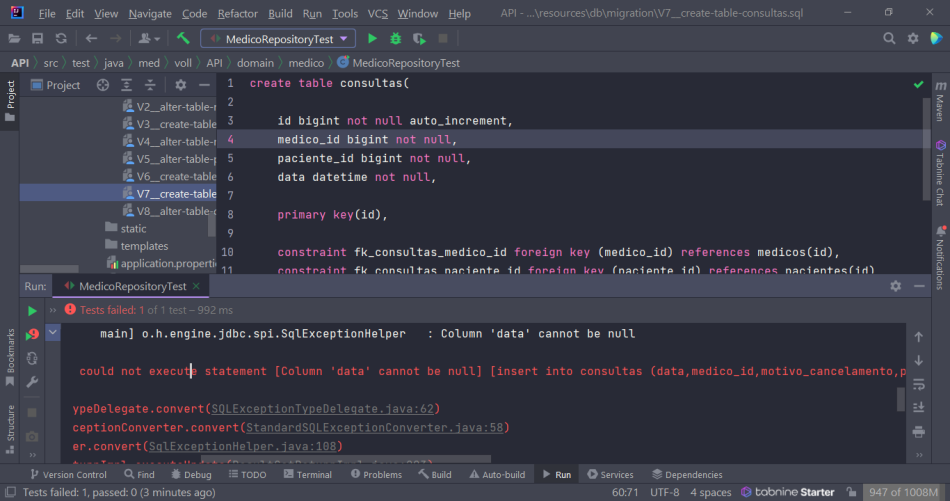Reasons Why You Encounter 'Column Cannot Be Null' in Hibernate with OneToMany and How to Resolve It
 Tuanhdotnet
Tuanhdotnet4 min read

Source: Reasons Why You Encounter 'Column Cannot Be Null' in Hibernate with OneToMany and How to Resolve It
1. What Causes the 'Column Cannot Be Null' Error?
The error occurs when Hibernate attempts to persist an entity that violates a database constraint requiring a non-null column. While the message seems straightforward, its roots can be complex, often tied to misconfigurations in the OneToMany mapping.
1.1 Misconfigured @JoinColumn Annotation
In a OneToMany relationship, Hibernate uses a foreign key column to link the parent entity to its child entities. If the @JoinColumn annotation is not properly configured, Hibernate might attempt to insert null values into the foreign key column.
@Entity
public class Parent {
@Id
@GeneratedValue(strategy = GenerationType.IDENTITY)
private Long id;
@OneToMany(mappedBy = "parent", cascade = CascadeType.ALL)
private List<Child> children = new ArrayList<>();
}
@Entity
public class Child {
@Id
@GeneratedValue(strategy = GenerationType.IDENTITY)
private Long id;
@ManyToOne
private Parent parent; // No @JoinColumn specified
}
In this example, the Child entity lacks an explicit @JoinColumn. Hibernate defaults to a foreign key column named parent_id, which, without proper assignment, may be null during persistence.
1.2 Missing Bi-Directional Association Handling
When a OneToMany relationship is bi-directional, both parent and child entities must be aware of their association. Forgetting to set this link explicitly often results in null foreign keys.
Parent parent = new Parent();
Child child = new Child();
// Nochild.setParent(parent)here
parent.getChildren().add(child);
entityManager.persist(parent);
In this scenario, the Child entity’s parent field is never initialized, so Hibernate attempts to persist a null value into the parent_id column.
1.3 Cascade and Orphan Removal Misconfigurations
Improperly configured cascade or orphan removal settings can lead to Hibernate persisting incomplete or detached child entities, which may have null foreign keys.
2. Resolving 'Column Cannot Be Null' in Hibernate
Resolving this error requires addressing the underlying causes systematically. Here’s how to fix the most common scenarios.
2.1 Specify the @JoinColumn Explicitly
To avoid ambiguities, always define the @JoinColumn annotation in the ManyToOne relationship.
Solution Example:
@Entity
public class Child {
@Id
@GeneratedValue(strategy = GenerationType.IDENTITY)
private Long id;
@ManyToOne
@JoinColumn(name = "parent_id", nullable = false) // Ensures non-null foreign key
private Parent parent;
}
This explicitly tells Hibernate to use parent_id as the foreign key and ensures that it cannot be null.
2.2 Maintain Bi-Directional Associations
When working with bi-directional relationships, ensure both entities are correctly linked. A helper method in the parent class can simplify this process.
Solution Example:
@Entity
public class Parent {
// Other fields...
public void addChild(Child child) {
children.add(child);
child.setParent(this); // Establish bi-directional relationship
}
}
Usage:
Parent parent = new Parent();
Child child = new Child();
parent.addChild(child);
entityManager.persist(parent);
This ensures that the Child entity’s parent field is always initialized correctly.
2.3 Use Cascading Persist Operations
To avoid manually persisting child entities, configure cascading operations in the parent entity.
Solution Example:
@OneToMany(mappedBy = "parent", cascade = CascadeType.PERSIST)
private List<Child> children = new ArrayList<>();
With this configuration, persisting the Parent entity automatically persists all associated Child entities.
2.4 Avoid Orphan Entities
If using orphanRemoval = true, ensure all child entities are explicitly linked to a parent before persistence.
3. Advanced Considerations
3.1 Use of Default Values in the Database
While Hibernate handles object persistence, default values in your database schema can provide an additional safety net.
Example:
ALTER TABLE child ALTER COLUMN parent_id SET DEFAULT 1;
This ensures that even if a null value is mistakenly passed, the database assigns a default value.
3.2 Debugging Hibernate SQL
To identify the root cause of the issue, enable Hibernate SQL logging. This reveals the exact SQL statements being executed.
Configuration Example:
hibernate.show_sql=true
hibernate.format_sql=true
3.3 Validate Entity State Programmatically
Before persisting entities, validate their state to ensure all required associations are properly initialized.
Example:
if (child.getParent() == null) {
throw new IllegalStateException("Child must have a parent before persisting.");
}
4. Conclusion
The 'Column cannot be null' error in Hibernate, especially with OneToMany relationships, often stems from misconfigurations or missing associations. By carefully defining @JoinColumn, maintaining bi-directional relationships, and leveraging cascading persist operations, you can resolve and prevent this error. Debugging tools like SQL logging and validation checks further enhance your ability to identify and address issues.
If you’ve encountered challenges or have questions about your specific use case, feel free to share them in the comments below. Let’s explore solutions together!
Read more at : Reasons Why You Encounter 'Column Cannot Be Null' in Hibernate with OneToMany and How to Resolve It
0
Subscribe to my newsletter
Read articles from Tuanhdotnet directly inside your inbox. Subscribe to the newsletter, and don't miss out.
Written by

Tuanhdotnet
Tuanhdotnet
I am Tuanh.net. As of 2024, I have accumulated 8 years of experience in backend programming. I am delighted to connect and share my knowledge with everyone.